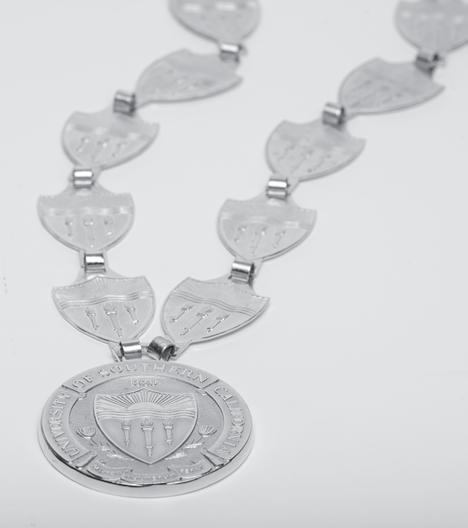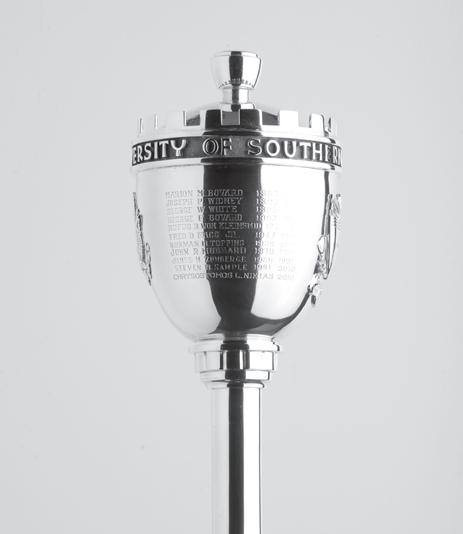
8 minute read
Academic Regalia
The) wearing of gowns by judges, ministers, teachers, and “(The) wearing of gowns by judges, ministers, teachers, and scholars is an ancient and impressive custom. . . . As the graduat-scholars is an ancient and impressive custom. . . . As the graduing students of American high schools, colleges, and universiating students of American high schools, colleges, and univerties march in academic procession on Commencement Day to sities march in academic procession on Commencement Day receive their diplomas or degrees, they, too, (and perhaps, for to receive their diplomas or degrees, they, too, (and perhaps, some, only this once in their lives) wear the caps and gowns of for some, only this once in their lives) wear the caps and this long tradition. . . . For a moment, they are wearing an ancient gowns of this long tradition. . . . For a moment, they are wearregalia, the proud badge of belonging to a great profession, that ing an ancient regalia, the proud badge of belonging to a great of student. Holding hands with students past and students present in a chain which goes back into history. Every detail should be keyed to stress the occasion as adventure, a turning point, some profession, that of student. Holding hands with students past and students present in a chain which goes back into history. Every detail should be keyed to stress the occasion as adventure, a turning point, something memorable and important.” thing memorable and important.”
Frank C. Baxter Frank C. BaxterProfessor Emeritus of English Professor Emeritus of English University of Southern California University of Southern California
Advertisement
At the end of the 19th century, colleges and universities in the United States were developing the kind of ruleless academic costume that emerged from the centuries in Great Britain. There and in the dominions, each university adopted its own costume without regard to what other institutions had done. The result was a confusing array of caps, gowns, and particularly hoods, each one of which must be separately memorized.
Recognizing this problem, American institutions responded in 1895 by creating an intercollegiate commission to consider a uniform code for academic costume. The resulting Intercollegiate Code regulated the design or pattern of gowns and hoods and the colors and materials to be used. The code was subsequently adopted by almost all of the colleges and universities in the country. It is still in use today, although slightly modified by successor committees appointed by the American Council on Education.
Gowns The code provides for three types of gowns. Those for bachelor’s students are made of black material and have long, pointed sleeves. They should be worn closed. The master’s gown, also black, is made with an oblong sleeve, open at the wrist. The rear part of its oblong shape is square cut, and the front part has an arc cut away. It is also worn closed. In 2018, the university unveiled new custom regalia for bachelor’s and master’s students. The new gowns feature a cardinal band and the USC shield on the sleeves, along with cardinal piping. The custom regalia highlights the prestigious brand of USC in an elegant and timeless manner.
The doctor’s gown is an elaborate costume marked by velvet panels down the front and around the neck and by three bars of the same material on the bell-shaped sleeves. It is cut much fuller than the other gowns and may be ornamented in color. (As a matter of practice, except in the areas of philosophy and law—dark blue and purple, respectively—faculty colors are rarely seen on the gown.)
The standard cap and gown are almost universally worn, but there are some outstanding deviations, including Harvard, Princeton, Yale, Stanford, Columbia, New York, Chicago and the University of Southern California. Cardinal and gold doctoral gowns were proposed for the university’s centennial by Dr. Jerome B. Walker, centennial director, in 1980. Cardinal gowns with yellow velvet panels were first worn during President James H. Zumberge’s inauguration in May 1981. For President Steven B. Sample’s 1991 inauguration, the design for doctoral gowns was modified, adding red velvet panels framed by bright gold braids.
Caps Although there is an exception, rarely seen, for women that allows them to wear a soft cap, the mortarboard or Oxford-type cap is worn. Only the doctor’s cap may be made of velvet. The tassel worn with the cap has three variations: (1) it may be black for any degree, (2) it may be in the color of the faculty (field of learning) in which the degree was granted, or (3) doctors and governing officials, only, may wear a tassel of gold metallic thread. Black tassels are worn at USC for all bachelor’s and master’s degrees.
The cap is an essential part of the academic costume and is worn with it at all times except, of course, when the men remove theirs during prayer or during the playing of the national anthem. The gold tassel of the doctor’s cap is so fastened that it drapes over the left front quarter of the cap. From this design, it has become customary to leave the tassel draped over the left temple at all times.
Hoods Of all the components of the costume, the hood is the most symbolic. It makes clear the level of the degree, the faculty in which it was given and the institution which awarded it. The level of the degree is shown by the size of the hood, the width of the velvet trimming, and in the case of the doctors, by the shape. The hood is lined with the colors of the school awarding the degree; at USC, the silk lining is gold with a cardinal chevron. The color of the velvet band around the hood shows the department in which the wearer has taken his or her degree. All master of arts (white) and master of science (gold) degrees are bestowed by the Graduate School. The color of the velvet band around the hood for all PhDs is dark blue. Specialty degrees have individual colors based on the degree earned.
The academic regalia worn by the participants in the commencement ceremony is not merely costume. It represents an unbroken chain uniting students and scholars since the Middle Ages.
Presidential Medallion of Office The medallion of office is worn by the president over his official regalia at ceremonial occasions. It was created by Associate Provost Jerome B. Walker for the inauguration of President James H. Zumberge on May 10, 1981 to serve as a tangible symbol of the authority vested in the president by the Board of Trustees. For his 1991 inauguration, President Steven B. Sample asked Dr. Walker to design the medallion’s current chain, which consists of shields identical to that found in the university seal, linked together 16 times.
The front of the medallion depicts the university seal in full, and the back lists the name of the current president and the date of his inauguration. Each president keeps his medallion after retirement. For his 2010 inauguration, Dr. C. L. Max Nikias directed that two copies of the medallion be created. One copy will be worn by the president at appropriate events, while the other will be displayed in the Office of the President. The displayed medallion will include the name of each of the past presidents of USC engraved on the links of its chain.

University Mace The mace is a ceremonial scepter symbolizing the authority of the Office of the President. The president of the faculty has the honor of serving as mace bearer in all academic processions for commencements and other official university ceremonies.
The university mace was first used at the inauguration of President Norman Topping on October 28, 1958. The mace was designed and crafted by the renowned master silversmith, USC alumnus and professor emeritus Hudson Roysher. The head of the mace depicts the university seal. Encircling the head of the mace is the hand-engraved inscription, “1880 University of Southern California.” The names of the university’s past presidents and the current president are engraved on the bowl. The crowning ornament is a depiction of the walled city of Troy. The mace is permanently displayed in the Office of the President.

Marshals’ Batons Designed for the inauguration of Dr. C. L. Max Nikias as 11th president of the university, a baton is carried by every marshal in the official procession. The batons are carved from walnut, with the university seal mounted in gold at the top. The fluted shape of the baton evokes the torch of learning, which is also found on the university seal.
At the University of Southern California, marshals are traditionally chosen from the ranks of the faculty to lead the student procession at the New Student Convocation and Commencement. The university marshal and the president of the faculty march at the head of the procession.

Trustee Gowns The cardinal robes of office worn by university trustees were designed by Dr. Jerome B. Walker for President James H. Zumberge’s 1981 inauguration. Reminiscent of the university’s doctoral gowns, the trustee robes feature red velvet front panels and chevrons on the sleeves. Bright gold piping outlines both the panels and the chevrons. Each of the front panels features an embroidered shield on the lapel, taken from the university seal. The trustees wear a doctoral hood lined with USC’s traditional gold satin with a cardinal chevron. The hood has a red velvet collar representing the university, in place of a faculty color representing a single discipline.
The university marshal wears a special gown that serves as a bridge between the trustee robes and the university’s doctoral gown, with the university seal embroidered on the lapel.

